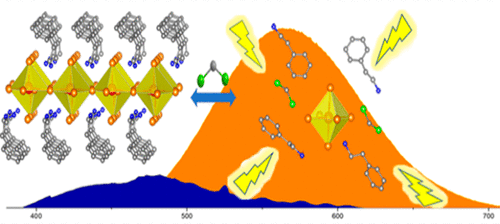当前位置:
X-MOL 学术
›
Chem. Mater.
›
论文详情
Our official English website, www.x-mol.net, welcomes your
feedback! (Note: you will need to create a separate account there.)
0D and 2D: The Cases of Phenylethylammonium Tin Bromide Hybrids
Chemistry of Materials ( IF 7.2 ) Pub Date : 2020-05-05 , DOI: 10.1021/acs.chemmater.0c01254 Liang-Jin Xu 1 , Haoran Lin 1 , Sujin Lee 1 , Chenkun Zhou 2 , Michael Worku 3 , Maya Chaaban 1 , Qingquan He 1 , Anna Plaviak 1 , Xinsong Lin 1 , Banghao Chen 1 , Mao-Hua Du 4 , Biwu Ma 1, 2, 3
Chemistry of Materials ( IF 7.2 ) Pub Date : 2020-05-05 , DOI: 10.1021/acs.chemmater.0c01254 Liang-Jin Xu 1 , Haoran Lin 1 , Sujin Lee 1 , Chenkun Zhou 2 , Michael Worku 3 , Maya Chaaban 1 , Qingquan He 1 , Anna Plaviak 1 , Xinsong Lin 1 , Banghao Chen 1 , Mao-Hua Du 4 , Biwu Ma 1, 2, 3
Affiliation

|
Tin halide perovskites and perovskite-related materials have emerged as promising lead-free hybrid materials for various optoelectronic applications. While remarkable progress has been achieved in the development of organic tin halide hybrids with diverse structures and controlled dimensionalities at the molecular level, some controversial results that have been reported recently need to be addressed. For instance, different photophysical properties have been reported for two-dimensional (2D) (PEA)2SnBr4 (PEA = phenylethylammonium) by several groups with distinct emission peaks at around 468 and 550 nm. Here we report our efforts in the synthesis of phenylethylammonium tin bromide hybrids with zero-dimensional (0D) and 2D structures, and characterizations of their structural and photophysical properties. 0D [(PEA)4SnBr6][(PEA)Br]2[CCl2H2]2 was found to exhibit strong yellow emission peak at 566 nm with a photoluminescence quantum efficiency (PLQE) of ∼90%, while 2D (PEA)2SnBr4 had weak emission peak at 470 nm with a PLQE of <0.1%. Interestingly, 0D [(PEA)4SnBr6][(PEA)Br]2[CCl2H2]2 can be converted into 2D (PEA)2SnBr4 upon drying, which would return to 0D [(PEA)4SnBr6][(PEA)Br]2[CCl2H2]2 upon addition of dichloromethane. Powder X-ray diffraction results confirmed the reversible transformation between 0D and 2D structures. Density functional theory calculations showed that excitons in 0D [(PEA)4SnBr6][(PEA)Br]2[CCl2H2]2 are highly localized, resulting in a strongly Stokes shifted broadband emission, while delocalized electronic states in 2D (PEA)2SnBr4 result in weaker exciton binding, a higher exciton mobility, and a higher nonradiative decay.
中文翻译:

0D和2D:苯乙铵溴化锡杂化物的情况
卤化钙钛矿和钙钛矿相关材料已经成为有前景的用于各种光电应用的无铅混合材料。虽然在分子水平上具有多种结构和受控尺寸的有机卤化锡杂化物的开发取得了显着进展,但最近有报道需要解决一些有争议的结果。例如,对于二维(2D)(PEA)2 SnBr 4报告了不同的光物理性质。(PEA =苯基乙基铵)的几个基团在468和550 nm附近具有明显的发射峰。在这里,我们报告了我们在合成具有零维(0D)和2D结构的苯乙铵锡溴化杂化物中所做的努力,以及它们的结构和光物理性质的表征。发现0D [(PEA)4 SnBr 6 ] [(PEA)Br] 2 [CCl 2 H 2 ] 2在566 nm处显示出强黄色发射峰,光致发光量子效率(PLQE)约为90%,而2D( PEA)2 SnBr 4在470 nm具有弱发射峰,PLQE <0.1%。有趣的是,0D [(PEA)4 SnBr 6 ] [(PEA)Br]2 [的CCl 2 ħ 2 ] 2可被转换成2D(PEA)2 SNBR 4在干燥时,这将返回到0D [(PEA)4 SNBR 6 ] [(PEA)BR] 2 [的CCl 2 ħ 2 ] 2当加二氯甲烷。粉末X射线衍射结果证实了0D和2D结构之间的可逆转变。密度泛函理论计算表明,激子在0D [(PEA)4 SnBr 6 ] [(PEA)Br] 2 [CCl 2 H 2 ] 2中高度局域化,导致强烈的斯托克斯位移宽带发射,而二维(PEA)2 SnBr 4中的局域化电子态导致更弱的激子束缚,更高的激子迁移率和更高的非辐射衰减。
更新日期:2020-05-05
中文翻译:

0D和2D:苯乙铵溴化锡杂化物的情况
卤化钙钛矿和钙钛矿相关材料已经成为有前景的用于各种光电应用的无铅混合材料。虽然在分子水平上具有多种结构和受控尺寸的有机卤化锡杂化物的开发取得了显着进展,但最近有报道需要解决一些有争议的结果。例如,对于二维(2D)(PEA)2 SnBr 4报告了不同的光物理性质。(PEA =苯基乙基铵)的几个基团在468和550 nm附近具有明显的发射峰。在这里,我们报告了我们在合成具有零维(0D)和2D结构的苯乙铵锡溴化杂化物中所做的努力,以及它们的结构和光物理性质的表征。发现0D [(PEA)4 SnBr 6 ] [(PEA)Br] 2 [CCl 2 H 2 ] 2在566 nm处显示出强黄色发射峰,光致发光量子效率(PLQE)约为90%,而2D( PEA)2 SnBr 4在470 nm具有弱发射峰,PLQE <0.1%。有趣的是,0D [(PEA)4 SnBr 6 ] [(PEA)Br]2 [的CCl 2 ħ 2 ] 2可被转换成2D(PEA)2 SNBR 4在干燥时,这将返回到0D [(PEA)4 SNBR 6 ] [(PEA)BR] 2 [的CCl 2 ħ 2 ] 2当加二氯甲烷。粉末X射线衍射结果证实了0D和2D结构之间的可逆转变。密度泛函理论计算表明,激子在0D [(PEA)4 SnBr 6 ] [(PEA)Br] 2 [CCl 2 H 2 ] 2中高度局域化,导致强烈的斯托克斯位移宽带发射,而二维(PEA)2 SnBr 4中的局域化电子态导致更弱的激子束缚,更高的激子迁移率和更高的非辐射衰减。































 京公网安备 11010802027423号
京公网安备 11010802027423号